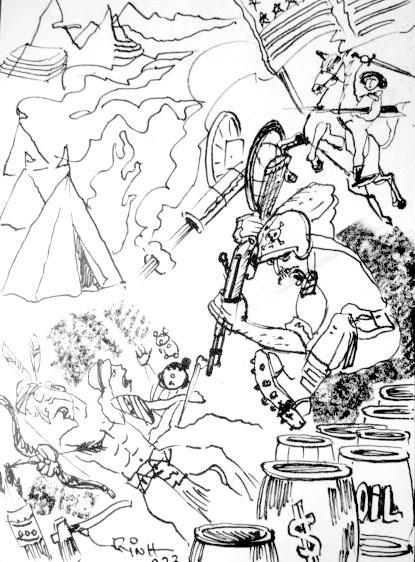 Talk Around Town
Talk Around Town

 |
| Illustration by Trịnh Lập |
by Nguyễn Mỹ Hà
The latest Martin Scorsese film Killers of the Flower Moon is now showing at cinemas in Việt Nam, and critics have wasted no time in richly praising all aspects of the picture.
The film is adapted from the book by journalist David Grann in 2017 about a series of uninvestigated deaths of the Osage women in Oklahoma in the 1920s. The book looked into the mystery of the Osage deaths in the early 20th century, when the area was considered the richest per capita in the world after oil was discovered under land allotted to the Reserves.
Grann wrote about how a white businessman befriended the Osage people to win their trust, but behind their backs staged brutal and cold-blooded murders of many Osage members simply to get to their money.
In 1906, after the Osage nation legally purchased and settled on a permanent reservation in north central Oklahoma Indian Territory, Osage, the Principal Chief negotiated with the US government to allot every full-blood Osage 657 acres of land that included a right in the tribe’s communal mineral trust.
A binding condition had it that it was these owners' right to receive a quarterly distribution of funds from the tribe’s underground mineral estate, which could only be inherited by their owner’s legal heirs.
Yet, the Osage were not free to spend their own money; if they were deemed incompetent, they would be assigned a guardian who controlled their money. The guardian would always be a white man, which is a cause for concern in itself.
This system was designed in a way to create conditions for the white man-guardians to withhold or steal money owned by the Osage.
The book dug deep into the ring’s crime, its mastermind and the 24 murders of the Osage that were never investigated.
“It was really about a culture of killing and a culture of complicity. Many of these murders were carried out by individuals who were profiting from this very corrupted system of targeting the Osage, often marrying into their families and then plotting to kill them to steal their oil money and inheritance,” Grann told media.
The horrors faced by the Osage also reflect the misery of all other people who were deprived of their territory, their wealth and property by greedy “guardians”.
Tale of murder
The cinematic adaptation of the book turns the plot into a love story of greed and murder.
Depicting the love between a World War I veteran, who worked as a taxi driver, and a rich beautiful Osage woman, who made a family with three children. The white man courted her, at the order of his uncle, who was also the ring leader and staged the murders of her sisters, and killed her mother.
Dumb as we may think this man could be, he passed on the orders to kill off his wife's family, without realising that in the end, he might even have to kill his own wife.
In a three-hour film stuffed with violence, male power and white superiority, the main heroine shone bright, by taking strong actions to bring her family tragedy into the daylight. Decisive, strong and smart, his wife gathered all her strengths after being injected with suspicious medication to cure her diabetes, to make a trip to appeal to the country's President, who heard the matter and sent detectives to investigate.
"Murders will out," as the old saying goes. The ring leader and his nephew got arrested, but after being manipulated for a long time, the dumb nephew refused to testify against his uncle. He wouldn't do so until his youngest child was also killed. When he decided to testify in court, his words, in turn, were held against him, and he was imprisoned.
The irony is that when the small family was torn apart and the ring leader went to prison, when he got out, he was still credited as a "good friend" of the Osage.
Looking at this matter, it's hard to believe that a man who tries to kill his woman's family to take their money would maintain any "love" for her. The courtship was clearly driven by greed.
At the film's premiere, Osage language consultant Christopher Cote reportedly told the Hollywood Reporter, that as an Osage himself, he was hoping the film would tell the perspectives of the Osage family.
"I think it would take an Osage to do that," Cote said. "Martin Scorsese not being an Osage, I think he did a great job representing our people. They kind of give him this conscience and they kind of depict that there's love. But when somebody conspires to murder your entire family, that's not love. That's beyond abuse."
History or art
Still, the illusion of romance is what the film wishes to create. But it's such a tough job for the film to win justice for the Osage people, and it ends up commemorating the talent and expertise of three white men: the director, main character and the supporting role.
When a work of art is adapted from a non-fiction book, people tend to take it as history itself. This is the power of cinema. Seeing is believing. People tend to believe what they see in a creative work of art as the truth, especially on film.
The main heroine, played by Lily Gladstone, got little or no mention at all in many reviews and wider media. Time will tell if she gets the recognition she deserves.
It reflects a truth that's hard to swallow: no matter how much people talk about gender equality, white superiority, so closely associated with greed, eats up everything around it.
The plight of the Osage community, or other Indian tribes in the US in the early days of the country, and later today on a larger world scale, reflects the plight of less powerful nations and communities around the world; they are invariably swallowed up by the greed of a small select group of people in power. VNS




